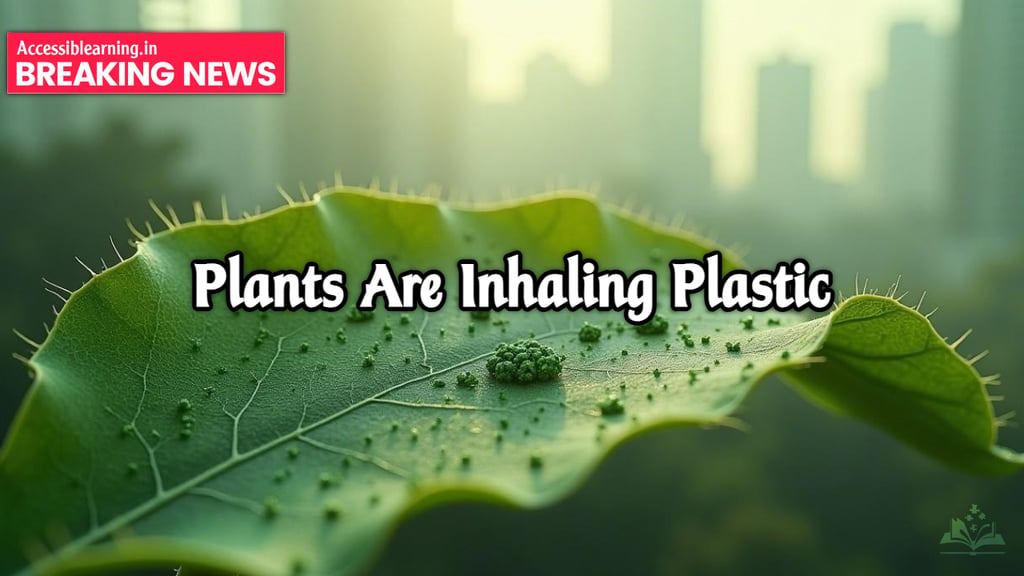
Study Reveals Widespread Absorption of Airborne Microplastics by Plant Leaves
A new study reveals that plant leaves are absorbing airborne microplastics through stomata, raising alarming concerns about food safety, environmental pollution, and ecosystem health. Learn how this impacts agriculture, urban greenery, and human health in this in-depth report.
ENVIRONMENTAWARE/VIGILANTNEWS/CURRENT AFFAIRSHARSH REALITY
Sachin K Chaurasiya
4/16/20254 min read


A groundbreaking scientific study has unveiled a disturbing truth: plant leaves are not just passive victims of environmental pollution — they are absorbing airborne microplastics at an alarming rate. This revelation doesn’t just highlight another pathway for microplastic infiltration but also forces a reevaluation of our entire relationship with the environment, agriculture, and food safety.
Airborne Microplastics: An Invisible Threat Lurking Overhead
We already know that microplastics — particles smaller than 5 mm — have invaded our oceans, soils, and even drinking water. However, their presence in the air has received far less attention. Scientists have now confirmed that tiny plastic particles suspended in the atmosphere can deposit onto plant surfaces — and even find their way inside.
Airborne microplastics are mainly generated by urban activities like
Tire wear from vehicles
Synthetic clothing fibers from laundry exhaust
Industrial dust and construction debris
Plastic waste incineration
Once airborne, these particles can travel vast distances — even across continents — before settling on the surface of leaves.
The Absorption Mechanism: How Microplastics Enter Plants
The study, conducted by researchers from the Chinese Academy of Sciences and Lancaster University, involved both lab simulations and real-world sampling. Using scanning electron microscopy (SEM) and confocal laser scanning microscopy, the team observed how microplastics adhered to and penetrated leaf surfaces.
Key findings:
Microplastics enter through stomata (tiny pores on leaf surfaces used for gas exchange).
Once inside, they can become lodged in mesophyll tissues, where photosynthesis occurs.
The study detected various polymer types, including polyethylene (PE), polypropylene (PP), polystyrene (PS), and PET.
This means that plastic isn't just sitting on the surface — it's becoming embedded in the very structure of plant life.
Urban Flora Hit the Hardest
Urban areas are hotspots for airborne microplastics, and vegetation in these settings bears the brunt. In cities like Shanghai and London, leaf samples collected from roadside trees, parks, and gardens revealed higher plastic concentrations compared to those in rural areas.
Even more concerning is the variety of shapes found:
Fragments: Broken pieces from larger plastics
Fibers: Likely from clothing and textiles
Films: Often from packaging materials
The diversity in shape suggests multiple sources and points to the complex challenge of tracing microplastic origins.
Agriculture at Risk: Could Our Food Be Plastic-Contaminated?
This discovery raises an urgent question — if urban plants absorb microplastics, what about our food crops?
Crops like spinach, lettuce, and kale have thin leaves and large stomatal openings, making them more vulnerable. If plastic particles are making their way into the edible parts of plants, there could be direct consequences for human health.
Previous studies have shown microplastics in root vegetables (e.g., carrots, radishes), but this study suggests leafy greens might also be at risk, especially in farms near urban or industrial zones.


Human Health Concerns: From Leaf to Plate
The infiltration of microplastics into plants could create a new route for human exposure — especially concerning when these plants are used in food, animal feed, or herbal medicine. While the exact health effects are still being studied, microplastics are already suspected of causing:
Inflammation and immune disruption
Hormonal imbalances (due to plastic additives like BPA)
Potential carcinogenic effects
Moreover, nanoplastics — which are even smaller than microplastics — could pass through the blood-brain barrier and placental barrier, making this a potential multigenerational concern.
What Scientists Plan to Study Next
The researchers emphasize that their work is just the beginning. Future studies will investigate:
Whether edible crops absorb microplastics to the same extent
How plastic pollution affects plant physiology, including growth and nutrient uptake
Whether microplastics can travel from leaves to stems, roots, and fruits
The impact of plastic exposure on pollinators like bees, who interact with plant surfaces regularly
This opens the door to cross-disciplinary studies involving botany, environmental science, agriculture, toxicology, and even climatology.
A Global Concern: It's Not Just One Country’s Problem
Airborne microplastics are a global pollutant, not limited by borders. Studies have documented plastic particles in the Arctic, on mountaintops, and deep within rainforest ecosystems. Wind and weather patterns carry them far from their origin, meaning no ecosystem is truly safe.
Even remote regions like the Himalayas and the Andes have shown traces of plastic fallout, proving just how widespread this crisis has become.
What Can Be Done: From Individual Action to Policy Change
While the study doesn’t offer a magic solution, it underlines the urgency for collective action. Here’s what we can do:
On an individual level
Minimize plastic use (opt for reusable bags, containers, and clothes made of natural fibers).
Support local farmers who practice organic, sustainable farming.
Plant more trees — especially broad-leaf trees that may help trap airborne particles.
On a policy and research level
Enforce regulations on plastic waste management.
Invest in biodegradable alternatives and sustainable packaging.
Increase urban green spaces that can serve as buffers against airborne pollutants.
Fund long-term research on microplastic toxicity and ecosystem impact.
This study is a wake-up call, not just for scientists, but for all of us. Plants are not only struggling to survive in a polluted world —they're also absorbing and internalizing our waste. From air purifiers to food sources, the greenery we depend on is under siege.
What lands on a leaf today may end up on your plate tomorrow.
Let this revelation spark a deeper commitment to rethink our plastic addiction and realign our choices with nature’s balance.
Subscribe To Our Newsletter
All © Copyright reserved by Accessible-Learning Hub
| Terms & Conditions
Knowledge is power. Learn with Us. 📚


